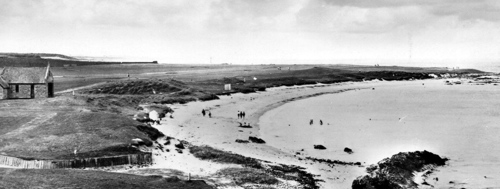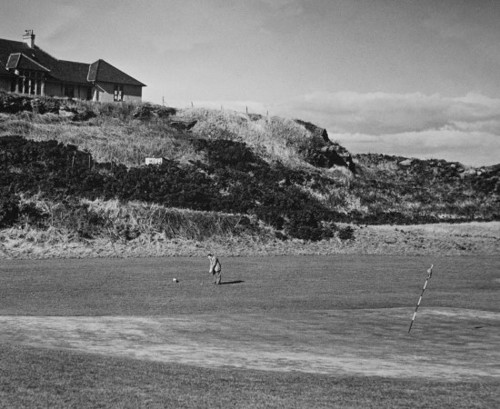Hole Names on Balcomie
The naming of golf holes dates back to the increasing use of scorecards in middle of the last century. Some hole names have become legendary, such as Troon’s ‘Postage Stamp’, or ‘The Road Hole’, whilst some names are common to a few golf courses owing to the similarities of a landscape feature. Across Scotland, there are a good number of ‘Spion Kop’ holes in tribute to Scottish soldiers who fought in the Boer war battle of that name. Similarly, you will find a few ‘Lang Whang’ holes across the land, which echo our love of the Scots language.

Hole 1 – Boathouse – The opening hole takes its name from the 19th century Lifeboat House which is situated to the right of the first green.
Hole 2 – Ower the Knowe – Literally “Over the Hill”, referring to the large mound in the fairway which is in line with the safe route to the green.
Hole 3 – The Briggs – The name given to the rock formation to the right of the hole where many a ship was wrecked in stormy waters coming around the headland. These rocks are very ancient and form part of the protected are known as a ‘Site of Special Scientific Interest’.
Hole 4 – Fluke Dub – Old Scots for the “flounder pool”, which was the name given to the area of the beach to the right of the dogleg.
Hole 5 – Hell’s Hole – Although this could easily describe the difficulty of the hole the name comes from the rocky area of the beach on the right of the hole.
Hole 6 – Wormiston – This comes from the name of the farm which once owned the land on which the hole was constructed and now borders this excellent par three.
Hole 7 – North Carr – The location of the North Carr Lightship out at sea was the perfect line for the tee shot here. The lightship is no longer there and the spot is marked out at sea by a single buoy. The lightship is now moored in the harbour at Dundee on the Firth of Tay.
Hole 8 – Breeches Buoy – The post situated half way along the fairway of this hole on the right hand side was the anchor post for a Breeches Buoy (which was a lifebelt with canvas breeches for the user’s legs) which was suspended from a rope which would have been fired by a rocket. This was a training aid, using the fairway as a soft landing for those being lofted along the rope. The image below gives an idea of what the pole would have looked like originally.

Hole 9 – Dykeside – This hole plays all the way to the green along the boundary wall of the course. Hence the name “Dyke (wall) side”.
Hole 10 – Castle Yetts – Yetts is an old Scottish word for a gate. The Castle gates refer to Balcomie Castle the remains of which, incorporated into Balcomie farm, can still be seen from the green. There is a village in central Scotland known as The Yetts of Muckhart.
Hole 11 – Lang Whang – “Whang” means to strike heavily. “Lang” means long. At 496 yards long Lang Whang is exactly what is required to complete the hole. The A70 road, running from Edinburgh to Ayr is known as the Lang Whang.
Hole 12 – The Burn – Situated approximately 50 yards short of the green, the water hazard gives the hole its name and is to be avoided. Even Jean Van de Velde would not try to play out of here.
Hole 13 – Craighead – A tough uphill par three played to a blind green near the pro shop located in front of the Craighead Farmhouse and steading. This hole has been immortalised in Michael Murphy’s cult classic “Golf in the Kingdom”. Craig is a simple derivation of Crag, or Rock.
Hole 14 – The Cave – below and to the right of the 14th tee is Constantine’s Cave so named as it was the location of the slaying by the Dutch invaders of King Constantine, King of the Scots, in the year 874. Or so it is said.
Hole 15 – Mill Dam – The pool to the left of the green is the site of a tidal mill dam remains of which can still be seen at low tide. There was a sluice gate that was opened to let the tidal water into the dam, during which time a waterwheel would power a mill wheel. The sluice would be closed and opened again when the tide was out, turning the mill again. The mill operated until the mid 18th century when coal power took over.
Hole 16 – Spion Kop – Named after the hill in South Africa (Spioenkop) where a battle was fought during the Second Boer War in 1900. This also why the Liverpool FC supporters end at Anfield is known as ‘The Kop’.
Hole 17 – Road Hole – One of the hardest holes on the course played over the access road to the former Coastguard Station from which the hole gets its name
Hole 18 – The Quarry – Named after the disused quarry on the right of the hole above which the clubhouse sits. It is believed that stones from this quarry were used to build the Scottish Church in Rotterdam Holland.

